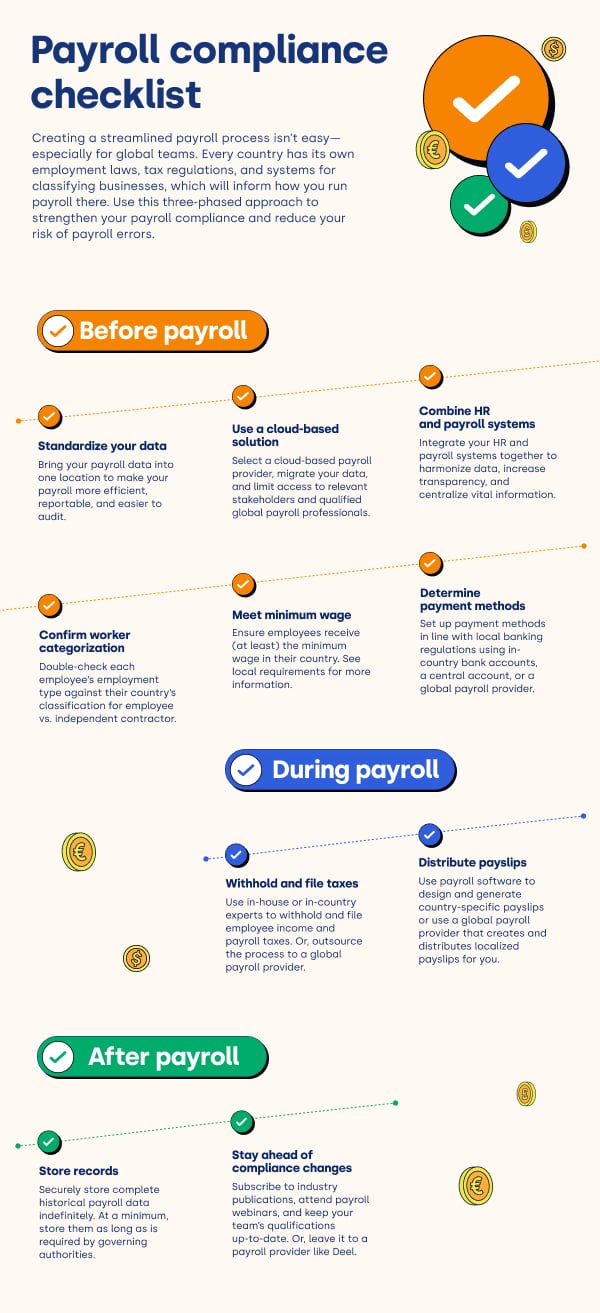
How Long Does It Take For Everyday Payroll To Process?

Key takeaways
- Some businesses have reported that the time taken for the payroll process totaled 21 days over the year.
- To speed up the payroll process, companies should use automated payroll processes and consider outsourcing their payroll to a global provider, like Deel.
- With Deel, you can mass pay your teams with just one click, and manage payments for direct employees, EOR employees, and independent contractors all in one platform.
The automated payroll process usually takes one to two business days. Once an employee submits payroll, employees can expect two to three days until their wages arrive in their bank account.
So, when using payroll processing software, employees will typically receive their pay within five days of the pay period’s end date.
However, the exact timeline depends on the payment method you use. Direct bank deposits, paper checks, and more modern methods like digital wallets take different amounts of time to process.
Let’s explore these various payment methods, the steps involved, and the ultimate turnaround time for your payroll to process.
Factors that affect the speed of payroll processing
The biggest bottleneck for payroll is the amount of time it takes for the person in charge of your payroll to make calculations and determine the exact amount each employee gets paid. More specifically, factors that determine the speed of payroll processing and the ultimate pay date include:
Automation vs. manual
Manual processing relies on spreadsheets and basic tools. They may appear less expensive, but businesses that use manual payroll spend more time and effort on payroll and experience far more errors.
A recent survey revealed that 49% of small businesses found the payroll process frustrating. Another 47% described it as complicated, and 44% said it was confusing. Overall, some businesses reported that the time taken for the payroll process totaled 21 days over the year.

An alternative to outdated manual payroll is automated payroll software. Especially when you factor in the time saved and errors prevented, automated payroll offers plenty of advantages and affordable pricing. It’s the single biggest step to speeding up the time it takes for payroll to process.
Related: check out our guide to small business payroll and taxes.
Regulatory changes
Payroll must comply with local and federal laws, and complying with new or changing regulations can significantly slow down payroll processes. Nevertheless, remaining compliant is essential to reduce payroll errors and penalties.
Recent regulatory changes include:
- 29 states and at least 40 local governments raised their minimum wage above the federal rate of $7.25
- 11 states and approximately 20 municipalities enacted laws that demand employers provide paid sick leave
- Eight states passed equal-pay laws that surpass the requirements stipulated in the federal Equal Pay Act
Compliance with state and national laws
You must also comply with new laws if you hire and pay employees in new states or countries.
Julien Couderc, Country Leader & Head of Expansion France, Deel via My RH Line
Each state within the US has its specific set of laws, and employers must follow state laws wherever each of their employees resides. For example, each state has unique wage garnishment laws, meaning the state may require employers to take money out of an employee’s paycheck to pay off unpaid loans.
Global payroll is a major challenge for businesses because each country has its own payroll taxes, local currencies, labor laws, data management laws, and more. If you choose to hire international employees, be aware of these hurdles (and your options for help).
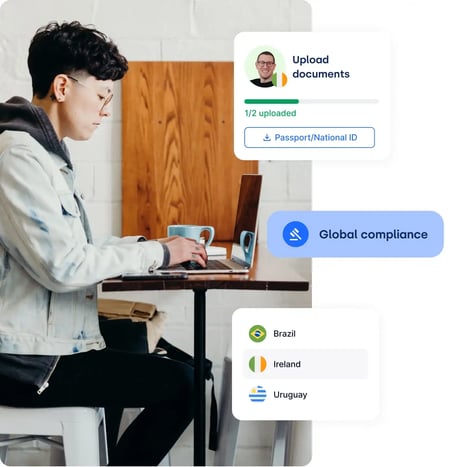
Managing overtime
Employees must pay higher wages for overtime. Keeping track of these hours is time-consuming and can cause a delay in processing. In some instances, employees submit their overtime time cards themselves. Delayed submissions can have an impact on the payroll too.
Processing times for popular payment methods
Businesses and employees have more options than ever for payments. Direct deposits have eclipsed paper checks in many industries, and some businesses even use digital wallets and crypto payment methods.
Each of these payment methods takes a different amount of time. Note: each estimated duration includes one or two days for internal payroll processes.
Direct deposits take 1-3 days
A direct deposit is an electronic method of paying funds into an employee’s bank account. The automatic process is fast, convenient, secure, and reduces the wait time for employees. As a bonus, the transactions leave accurate records that are easy to access.
If you want to use direct deposits, you must:
- Choose a payroll service provider
- Initiate the direct deposit process either through a banking portal or payroll software
- Collect information from employees, including bank account number, routing number, and signed authorization
- Enter employee banking information into your payroll system
- Create a direct deposit and payroll schedule and confirm payroll deadlines
- Run payroll
Once that happens, the bank packages all direct deposits and sends them to the ACH (Automated Clearing House) at regular, predetermined intervals. The ACH sends the direct deposit to each employee’s bank, which credits your employees’ savings or checking accounts accordingly.
The time taken to receive them will depend on the location of the two financial institutions. Transferring funds internationally can take longer than local transfers. Also, moving funds from one bank to another can take longer than transferring funds to an employee who uses the same provider as the business.
Looking for flexible global payment methods?
Offering your team multiple payment options attracts a bigger talent pool. See how we solve global payroll for international teams.
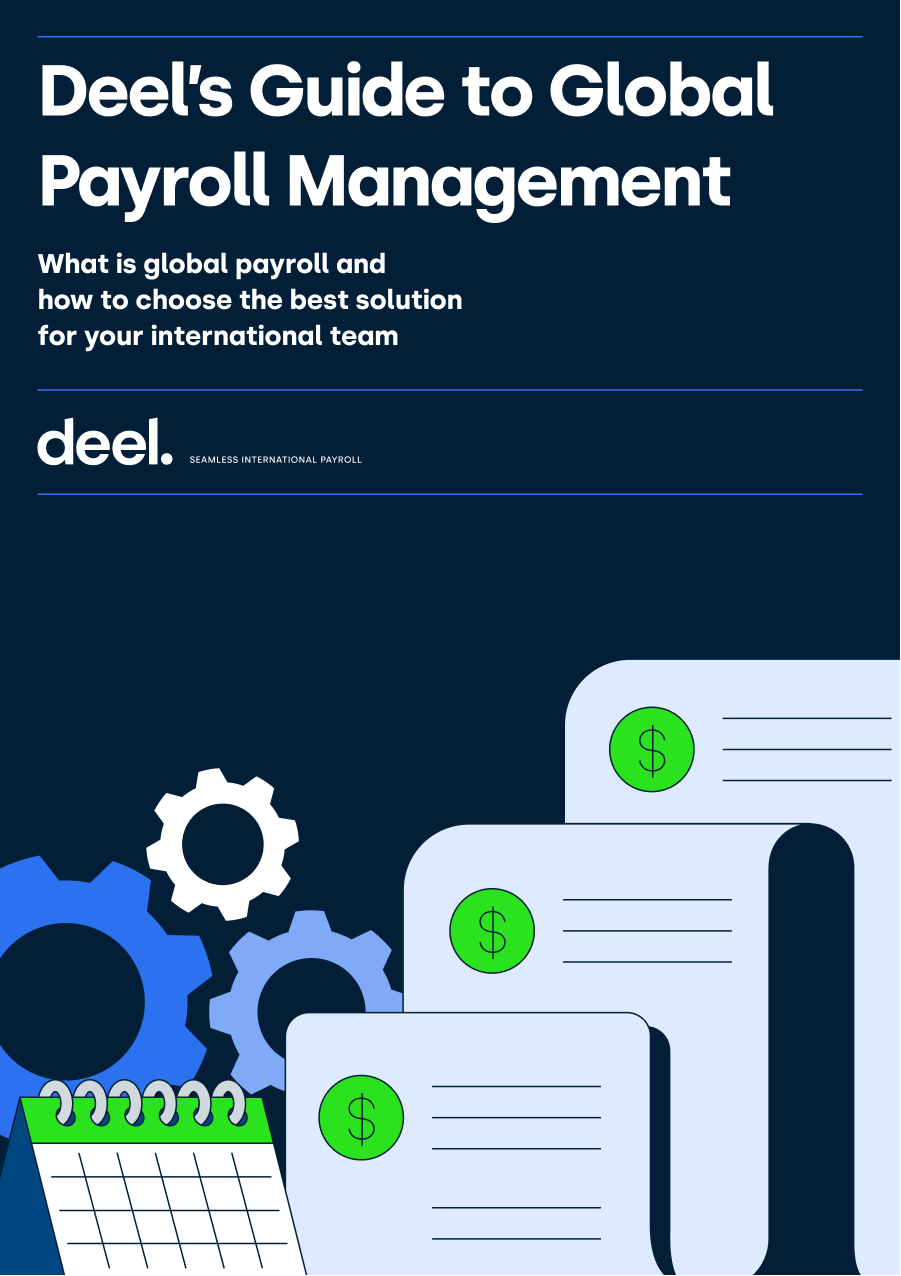
Paper checks take 2-5 days
Paying with a paper check involves handwriting the check and mailing (or hand delivering) the check to the employee. The employee then needs to deposit the check at the bank before the funds appear in their account.
On average, checks take two days to days to clear. If you pay employees with a physical, handwritten check, you need to give yourself at least five days’ lead time to ensure your employee receives the funds on time. Depending on the local mail service’s speed, you may need to add a few days to the turnaround time for the employee’s ultimate payday.
Paper checks are useful if an employee doesn’t have a bank account and can’t provide account information. Checks also provide a paper trail and places pay stubs directly in the employee’s hands. However, hand delivery and mailing the checks can take time and there’s the risk that they will get lost.
“The thing I love most about Deel is the multiple options to withdraw your funds. It makes it really simple to have your money—providing multiple withdrawal methods including crypto. Also, the withdrawals are seamless, and payments are on time.” — Tifuh Cedric, Turing
Digital wallets take 1-2 days
Transferring funds to a digital wallet is fairly instant once the internal payroll process is complete (accounting for one to two days).
Some payroll platforms have built-in digital wallets, and others allow you to send funds to other digital wallets. Digital wallets are extremely convenient and serve as a step forward toward going cashless. They can also sidestep fees that banks may charge.
Pay cards take 1-2 days
Prepaid debit cards can hold multiple salaries or wage payments to an employee and is an effective solution for those without a traditional bank account. One example is the Deel Card, which lets contractors withdraw funds directly to a VISA card they can use online or in stores.
Cards carry some risk because they can get stolen, and the employee will be charged an ATM fee for cash withdrawals. However, these cards are incredibly fast and flexible and can accept funds internationally without any issues.
What payment methods are available through Deel?
Deel clients can easily link new payment methods to their accounts, such as ACH, SEPA, BACS, PAD, Brex, credit card, and debit card payments. You can also pay with a manual transfer from your bank, Wise, or Mercury account, or send a cryptocurrency transfer through Coinbase.
During the payment workflow, you can choose your preferred payment method from the list and see where individual methods are available around the world, and review provider fees.
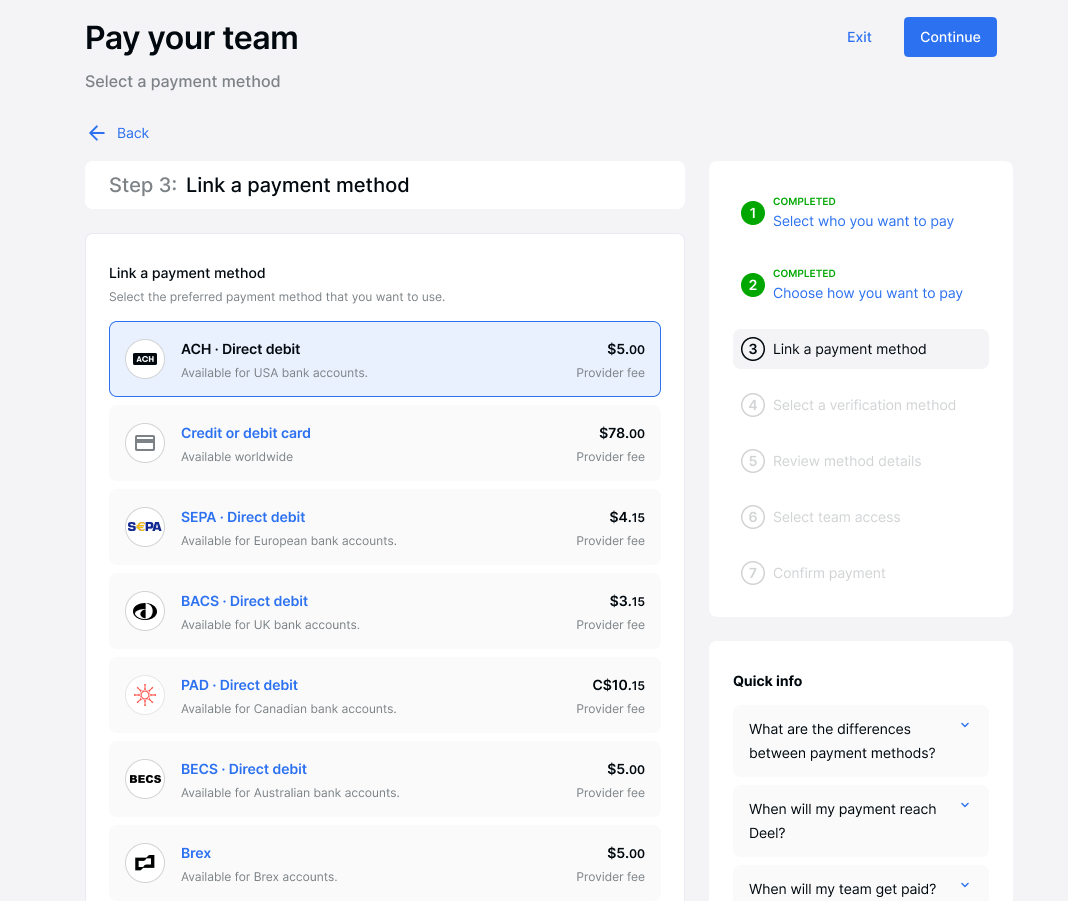
See also: Adding And Managing Payment Methods
How does payroll processing work?
Payroll processes have three main stages: pre-payroll, payroll, and post-payroll. The steps of how payroll works vary slightly depending on how you run your payroll process and whether you use an external payroll provider.
Internal payroll process
While each company has its own nuanced methods of running payroll, the following steps are universal.
- Gather and organize paperwork: make sure that you include the employer identification number (EIN), the employee’s tax identification number, and all accompanying financial information on the appropriate tax forms
- Set up a payroll schedule: consider various factors such as cash flow and submission deadlines
- Calculate gross pay: gross pay is the amount of money each employee earns before taxes–for hourly employees, gross pay depends on timesheets
- Make deductions: deduct payroll taxes such as social security and health insurance
- Pay employees: based on previous calculations, the employee receives the net pay
From the pay period end date, employees should receive their money within five days.
Keep a detailed record of each step in the process and ensure payroll records are up to date and accessible. Payroll software streamlines the process by automatically completing the calculations and triggering funds.
External payroll processes
Many businesses choose to outsource the process to a payroll service, such as Deel, that does the heavy lifting.
Deel’s Global Payroll simplifies the payroll process by enabling international teams to pay all of their workers in one place. With a network of legal and payroll experts spanning 150 jurisdictions, we provide end-to-end payroll and compliance—use your own entities to employ team members, and let us handle the rest:
- Payroll
- Compliance
- Deductions and benefits
- Tax filing and remittances
- Collecting pensions
- Payslips
- Offboarding
- Onboarding
When outsourcing payroll to Deel, our experts ensure payments are accurate and made on time according to employment contracts and compliant with local laws. Here’s a look at the process:
1. Select an entity with ‘Awaiting Funding’ status.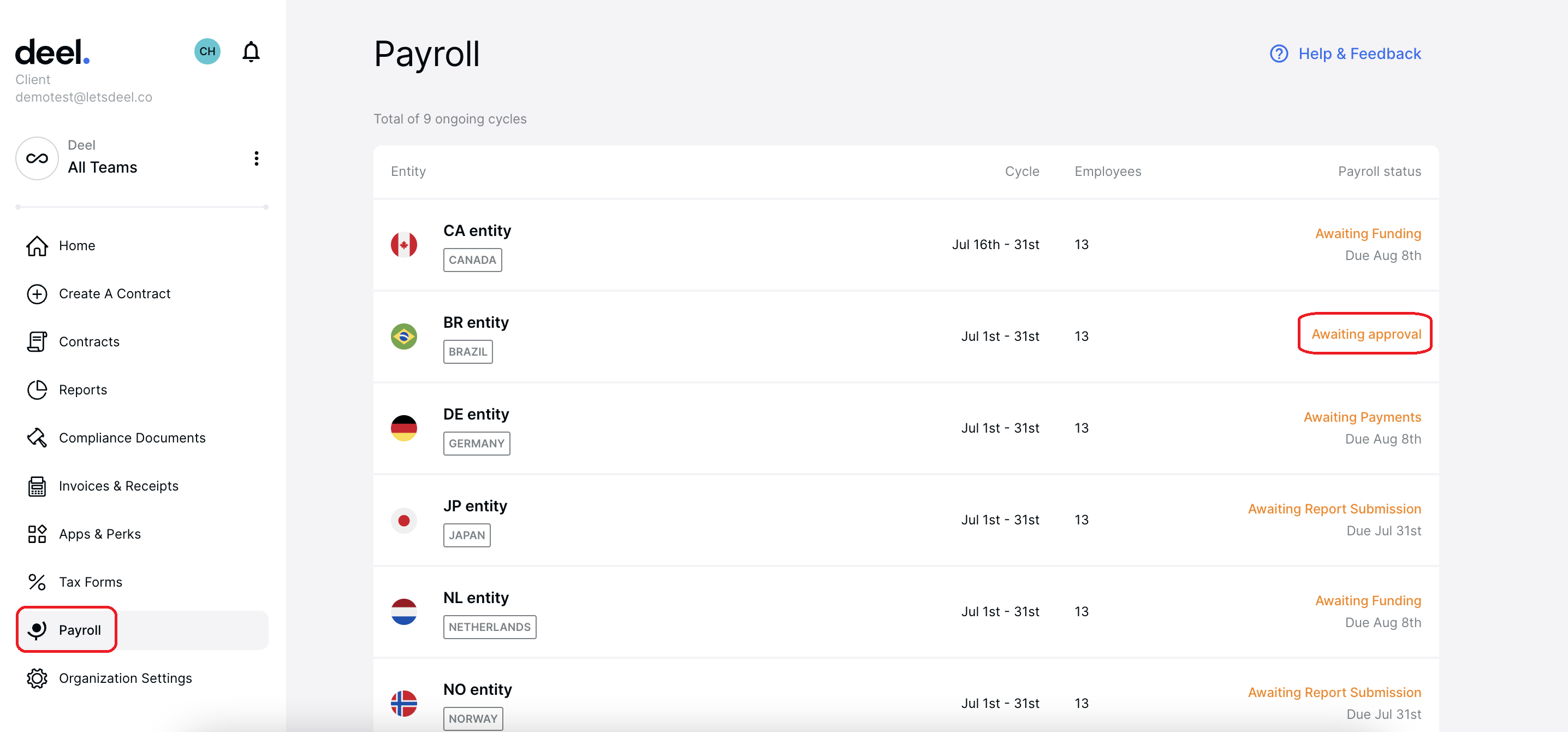
2. Click ‘Pay Funding’.
3. Select your payment method and follow the instructions for the payment flow. This phase of the process may include additional steps depending on your chosen payment method.
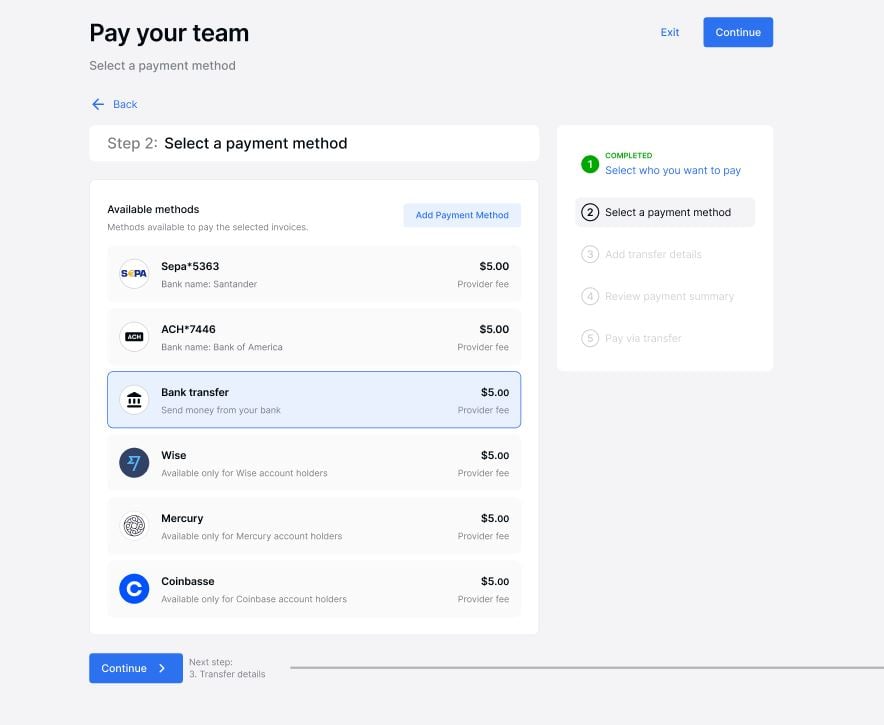
4. Review the payment summary and confirm payment.
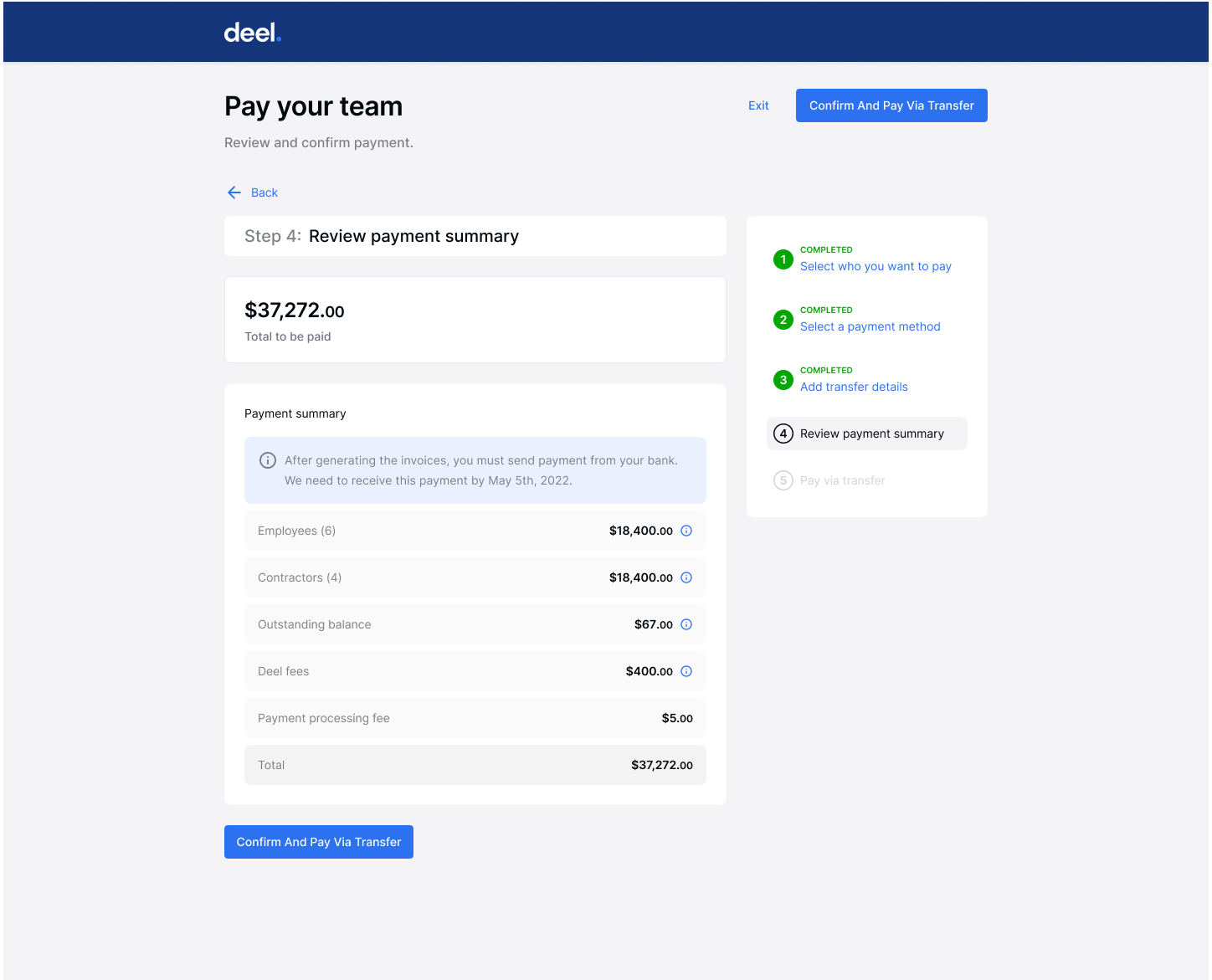
Note: This process walks you through the process of paying employees through Deel. If you are paying employees directly through a local payroll processor, Deel provides you with a CSV file and all necessary payment details to complete the process in the Deel dashboard. Watch the video below to see a walkthrough of the process.
Frequently asked questions about payroll processing
Learn more about payroll processing below.
Does international payroll take longer to process?
International payroll components add time and complexity to the payroll process. Each new country introduces different local laws and regulations, currencies, employee benefits, exchange rates, data procession laws, bank charges, and taxes.
However, the international payroll process shouldn’t stop you from global hiring. A global payroll solution such as Deel can streamline processes in a speedy and efficient way.
Why does payroll processing take so long?
Detailed tasks, such as calculating hours worked and taxes, take time and careful attention. The exact amount of time needed to process payroll depends on whether an organization uses payroll software or hires an external party.
Payroll compliance must also be completed before, during, and after running payroll, increasing the amount of time and resources required.
How do you speed up payroll processing?
The most effective ways to accelerate the payroll process is to:
- Use automated payroll systems
- Outsource payroll to a third party
- Offer flexible payroll schedules
- Enable multiple withdrawal and pay options
- Use a mass-payment solution to pay your entire team in one click
- Offer on-demand pay
See also: 5 Ways To Make the Payroll Process Faster and Easier for International Teams
What is on-demand pay?
On-demand pay is also known as earned wage access (EWA). This versatile payment option, offered by Deel to EOR employees, provides employees access to a part of their earned income before their regular payday.

This increased flexibility contributes to improved employee well-being and financial wellness, as it alleviates the financial stress of encountering unexpected expenses or budgeting issues. On-demand pay is often a superior alternative to revolving credit or payday loans, which is a common route for those who are late to pay bills or living paycheck to paycheck.
By providing employees early access to their funds, companies can improve employee engagement and satisfaction. Please note that on-demand pay is not the same as offering daily payroll (or daily pay) wherein workers can access their earned wages at the end of each workday, or the next day.
See also: How On-Demand Pay Unlocks Higher Employee Productivity, Satisfaction, and Retention
When is the payroll cutoff date for Deel?
At Deel, we offer an in-depth guide on the deadlines for payroll submissions. We use cut-off dates to lock our payroll reports and data, ensuring that the pay cycle goes off without a hitch. We use automation to process adjustments faster, which gives clients more time to make changes before the end of the cycle.
Deel offers EOR clients an extended cut-off period, granting payroll teams three times more time to manage their employees’ payroll adjustments. With our in-house payroll processing, we provide the flexibility to approve last-minute expenses, update time off, include commissions and bonuses, and submit monthly salaries until the twentieth of the month.
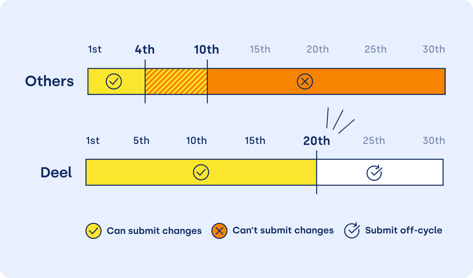
Unlike standard payroll service providers that collaborate with third parties and impose strict deadlines, Deel’s internal processing system allows us to be more accommodating in meeting your payroll needs.
What does a paycheck include?
A paycheck is a straightforward check. A pay stub or pay slip, outlines the employee’s payment in more detail. The document is fairly simple and includes summarized information from the payroll process, including:
- Employer information including the EIN and contact details
- Employee information including taxpayer identification number (TIN) or social security number
- Gross pay
- Net pay
- Pay rate
- Number of hours worked (including overtime hours)
- Paid time off
- Tax deductions (payroll taxes)
- Employer contributions and employee benefits
What is a typical payroll cycle?
Typical payroll cycles occur weekly, biweekly, semi-monthly, and monthly. Depending on your pay periods, you will move through the payroll process a set number of times. Bi-weekly payroll is common for hourly employees and has 26 checks per year.
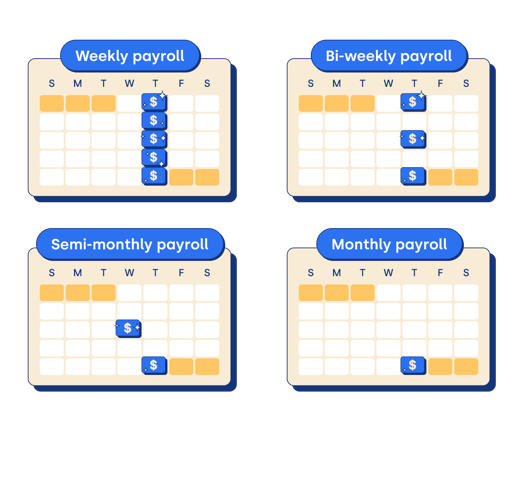
See also: Payroll Schedules: Types, Benefits, and How to Choose Between Them
Trust Deel with your global payroll
Paying your international workforce shouldn’t be an obstacle. While it can be overwhelming figuring out the best payment method or how to handle different currencies and bank charges, there’s a solution: Deel.
How Yodo1 expedites worker payments using Deel
Yodo1 manages payments for one-third of its people—spread across 30+ countries—using Deel. Before Deel, each payment for these workers was handled manually one by one.
Since launching with Deel, they’ve easily saved more than 100 work hours by streamlining repetitive or redundant tasks for their HR and Finance teams, and enabled their team members to get paid quickly.
“I hear all the time from our people that Deel is hands-down the fastest way they've ever been paid when working remotely. One of the comments I hear most often is how easy it is to receive and withdraw funds in so many currencies.” — Flo Alcasas, Head of People and Remote, Yodo1
Deel makes paying your team simple, no matter where they live. With one mass payment and a click, you can fund and pay your entire global team on time and in minutes. Deel also helps you pay independent contractors alongside employees without switching software.
Since Deel doesn’t use third-party providers to run Global Payroll, our implementation process is much quicker than competitors. Here’s what to expect from the Global Payroll setup process:
- Setup period: Meet with your dedicated Customer Success Manager (CSM) to provide the necessary information on your payroll, entities, and employees
- Data migration: Deel collects all necessary compliance documentation regarding entity onboarding, employee onboarding, and payroll onboarding
- Employee onboarding: Your dedicated CSM will migrate your EOR employees and independent contractors into the platform, and direct employees will onboard themselves via our self-service portal
- Approvals: You review and approve the determined payroll cycle and cut-off dates
- Shadow payroll: Deel will run one shadow payroll cycle, confirm that all logins and access requirements are correct, and that all benefits and adjustments have been properly applied
- Payroll configuration is complete
Are you ready to get started? Take the first step by booking a 30-minute demo today, where you’ll get a closer look at the Deel platform and the opportunity with an expert.
